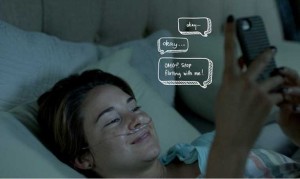
“A movie like Fault doesn’t look like a big visual effects movie. In fact, it’s not a visual effects movie, but it still has 350 VFX shots. That meant the tone was important. The VFX had to be completely seamless, invisible and naturalistic,” said Braver.
The film was shot on location in Pittsburgh and Amsterdam. During post, Braver was based in New York, while director Boone was in L.A. for the edit, so they relied on cineSync for communication.
“I think cineSync is a great tool for empowering a director. For this film, Josh had his office right next to editorial, so he could always pop in and jump on cineSync [with us in New York] and sometimes we’d cineSync two or three times a day, just because it’s so easy and convenient,” explained Braver. “During big reviews, we also had Skype open, so we could look each other in the eye while we were talking, while also seeing the shots we’re discussing in cineSync.”
The VFX vendors on the film were New York’s Phosphene, Spontaneous, Look FX and Scoundrel, as well as Pittsburgh’s Savage Visual Effects.
“I cineSync’d with every vendor apart from Phosphene who were literally around the corner from my office, but every other vendor, and editorial, we’d cineSync all the time.”
Overall the work was split into a couple of categories. The first category was the work carried out by Spontaneous, which revolved around the onscreen display of text messages Hazel and Gus, the two main characters send to each other.
“We decided really early on, during prep, that we can’t have people staring at phones for an entire movie. So we came up with a design for the text messages that have an aesthetic that fits the world of the movie,” said Braver. “When they text each other, there’s these animated text bubbles which we actually cel animated. Spontaneous hand drew them on vellum, scanned them and then animated them and composited them to really get a handmade feel. Because again this movie is so naturalistic, everything had to be grounded.
“The other work that was done was more traditional VFX,” he added. “In the movie, Gus has lost his leg to cancer and Phosphene did these fantastic shots where they replaced the actor’s leg with a prosthetic, mostly using 2D and 2.5D approaches. Then in one scene, after a love scene, we do this shot where we track up the bed and you see three legs, and then as we track up further we finally reveal his stump. That was one of the more complex shots, because we wanted the actor to be able to move naturally, so that effect ended up being a 2.5d projection with proxy geometry put on top, to accommodate dynamic camera moves.
Durning post, the film-makers felt that being immersed in cineSync sessions really helped concentrate on specific aspects of the movie.
“CineSync really works in terms of really being able to focus in on certain aspects of shots and to follow the progression of a shot from the first work in progress all the way through to final,” said Braver. “And I always have those versions loaded in a session. I find it’s really helpful with directors, because when something’s not working in a version, you can very easily step back a version and see if it was working there. That’s a really powerful weapon in terms of being able to get a shot looking good and finaled in the most expedient manner.”
“We have review tools available to us in other applications, but they’re not that useful in terms of what we needed on this show. I’ve been using cineSync as a tool for many years now, but it was really this movie when I said, ‘I really couldn’t picture getting this movie done on time without it,'” said Braver.





